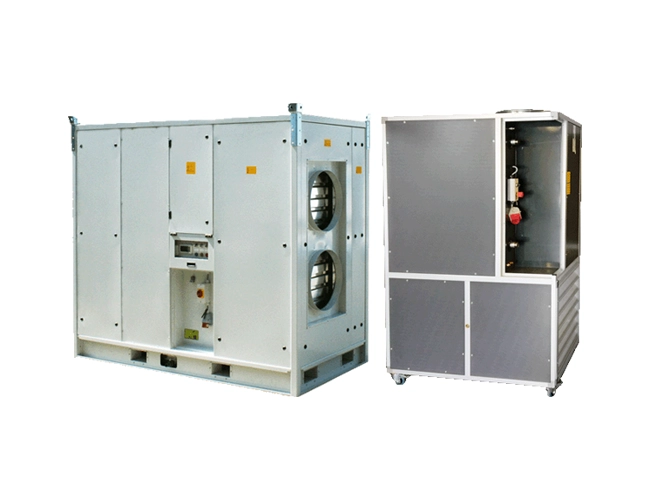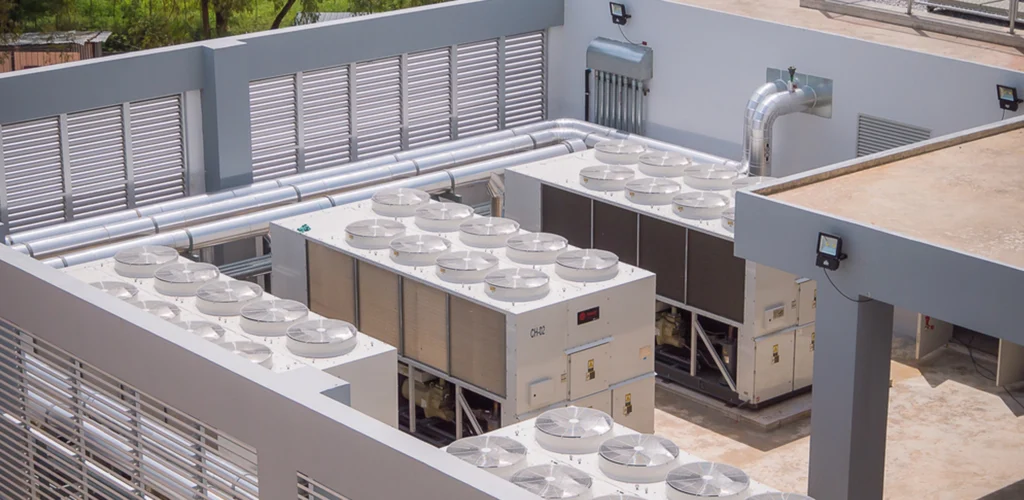Unlocking Efficiencies, Reducing Energy Consumption, and Maximising Savings in Operational Costs.
In the realm of HVAC (Heating, Ventilation, and Air Conditioning) systems, achieving optimal performance is not only about maintaining comfortable indoor environments but also about minimising energy consumption and operational costs. Chiller and Air Handling Unit (AHU) optimisation is a critical aspect of this endeavour, offering a pathway to greater efficiencies and substantial savings. In this article, we’ll delve into the strategies for optimising chillers and AHUs, explore their applications in temporary cooling solutions, and highlight considerations for end-users when hiring temporary chillers with AHUs.
Chiller and AHU Optimisation: The Path to Efficiency and Savings
Understanding Chillers and AHUs:
Chillers are central components in HVAC systems responsible for cooling water or other fluids, which are then circulated through the building to absorb heat. On the other hand, Air Handling Units (AHUs) are responsible for distributing conditioned air throughout the building. Both these systems play a pivotal role in maintaining indoor comfort and are integral to energy efficiency considerations.
Strategies for Optimisation:
Regular Maintenance: Scheduled maintenance is paramount for the efficient operation of chillers and AHUs. Regular inspections, cleaning, and component checks can identify potential issues before they escalate, ensuring optimal performance.
Advanced Controls and Monitoring: Implementing advanced control systems allows for precise monitoring and adjustment of chiller and AHU operations. Smart controls can optimise settings based on real-time conditions, reducing energy wastage.
Variable Speed Drives (VSDs): VSDs enable chillers and AHUs to adjust their speed based on demand. This not only enhances energy efficiency but also prolongs the lifespan of equipment by reducing wear and tear associated with frequent starts and stops.
System Upgrades: Investing in energy-efficient technologies and upgrading older systems can significantly enhance overall performance, leading to energy savings and operational cost reductions.
Temporary Chillers and AHUs: Meeting Short-Term Cooling Needs
In scenarios where buildings require temporary cooling solutions, the integration of temporary chillers with AHUs becomes a versatile option. This is particularly common in situations such as planned maintenance shutdowns, events, or emergencies where the existing HVAC system may be temporarily inadequate.
Applications of Temporary Chillers and AHUs:
Event Cooling: Temporary chillers with AHUs are often employed for cooling large-scale events, such as outdoor weddings, concerts, or festivals, where the existing HVAC system may not suffice.
Emergency Cooling: In the event of an HVAC system failure or during planned maintenance, temporary chillers and AHUs provide a quick and effective solution to maintain a comfortable indoor environment.
Construction and Renovation Projects: During construction or renovation activities, where the permanent HVAC system is not yet operational, temporary chillers and AHUs are deployed to meet immediate cooling needs.
What to Know Before Hiring Temporary Chillers with AHUs
Capacity Requirements: Assess the cooling capacity required for the specific application. Understanding the size of the space and the expected heat load ensures that the temporary chiller and AHU system can meet the demand effectively.
Compatibility: Ensure that the temporary chiller and AHU are compatible with existing building systems. Compatibility issues can lead to inefficiencies and suboptimal performance.
Energy Efficiency: Inquire about the energy efficiency ratings of the temporary chiller and AHU units. Choosing energy-efficient equipment not only reduces operational costs but also aligns with sustainability goals.
Installation and Setup: Consider the ease of installation and setup. Efficient setup processes minimise downtime and ensure that cooling needs are met promptly.
Maintenance and Support: Verify the maintenance requirements and availability of support services. A reliable support system is essential for addressing any issues promptly and maintaining continuous operation.
In conclusion, chiller and AHU Optimisation are key elements in the pursuit of energy efficiency and cost savings within HVAC systems. Temporary chillers with AHUs offer flexible solutions for short-term cooling needs, but end-users must carefully consider factors such as capacity, compatibility, energy efficiency, and maintenance before making hiring decisions. By embracing Optimisation strategies and making informed choices, businesses can create comfortable indoor environments while simultaneously reducing their environmental footprint and operational costs.
Do you have a temporary chiller and/or an AHU requirement? Call Rapid Energy today on 0800 464 7025.













